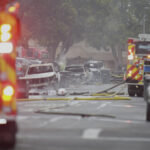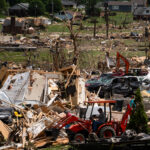Firefighters made more progress Wednesday morning against a giant wildfire that has ravaged a national forest north of Los Angeles, with another day of cooperative weather providing a big assist to beleaguered fire crews.
The blaze in the Angeles National Forest had burned nearly 219 square miles, or 140,150 acres, by early Wednesday. Firefighters have created a perimeter around 22 percent of the blaze, largely by removing brush with bulldozers and setting controlled burns. Bulldozers still have 95 miles of fire line to build.
“The crews are making excellent progress based on the improved weather conditions,” U.S. Forest Service incident commander Mike Dietrich at a Wednesday news conference.
Gov. Arnold Schwarzenegger visited the fire area Wednesday morning and served breakfast to firefighters, scooping Cream of Wheat into paper bowls and giving them plenty of protein so “they get all pumped up for the next fight out there with those fires.”
Since erupting Aug. 26, the blaze has burned more than five dozen homes, killed two firefighters and forced thousands of people from their homes. The cause was still not known.
Officials also were keeping a close eye on the wind, which had been calm overnight but could pick up Wednesday afternoon and move flames closer to homes and a historic observatory. Mount Wilson is currently strongly defended.
U.S. Forest Service incident commander Mike Dietrich was not willing to say a corner had been turned.
In a hillside neighborhood of Glendale, Frank Virgallito stood in a group anxiously watching a controlled burn edge toward their neighborhood.
Virgallito said he and his neighbors had been on high alert since Friday but ignored a voluntary evacuation.
“You don’t sleep well,” Virgallito said. “I get up every hour and a half or two hours to get a good view of where the fire is. For four days we’ve been a little sleep-deprived. It’s unnerving.”
Virgallito said he saw deer, coyote and skunks scampering down his street away from the heat and ash of the smoldering wilderness.
Officials also worried about the threat to a historic observatory and TV, radio and other antennas on Mount Wilson northeast of Los Angeles. But on Tuesday, firefighters set backfires near the facilities before a giant World War II-era seaplane-turned-air tanker made a huge water drop on flames inching toward the peak from the north and west.
By nightfall, 150 firefighters and engines were stationed at the peak to defend the towers, said fire spokesman Paul Lowenthal.
The flames crossed the Angeles Crest Highway into the San Gabriel Wilderness to the east on Tuesday, Lowenthal said. Firefighters made progress on fire breaks to the north near Acton and southwest from Altadena to the Sunland neighborhood.
Firefighters and longtime residents know it could be so much worse. Autumn is the season for the ferocious Santa Ana winds to sweep in from the northeastern deserts, gaining speed through narrow mountain canyons, sapping moisture from vegetation and pushing flames farther out into the suburbs.
“If we had Santa Anas, we still have all this open land here on the western flank and islands of vegetation would throw embers into the air, which would blow down to the homes,” Fire spokesman Henry Martinez said, his voice trailing off as he imagined the worst-case scenario. “Let’s hope that doesn’t happen.”
The wildfire season usually doesn’t gather steam until the winds hit in October, but the Station fire has been driven by dryness instead of wind. The region is in the midst of a three-year drought, and the tinder-dry forest is ripe for an explosive fire.
Fire officials said 12,000 homes were threatened, but as evacuations are lifted, that number will likely fall.
Smoke billowed thousands of feet up in the air, forming what firefighters call an “ice cap,” which dissipated and was pushed east for at least 800 miles.
In Colorado, smoke from the Station Fire combined with soot from local fires to block mountain views from Denver.
“That really speaks to the columns of smoke and how much burning was going on,” said Norv Larson, a meteorologist with the National Weather Service in Grand Junction, Colo.
“I’ve put haze in the forecast. I don’t see it ending anytime soon,” Larson said. “We’ve got our fires here, you’ve got your fires there.”
Flames charred other parts of Southern California, including one that burned at least 1.5 square miles in the San Bernardino County community of Oak Glen and another that threatened 400 homes in Yucaipa and was at 70 percent containment.
“There’s action everywhere,” Gov. Arnold Schwarzenegger said as a helicopter interrupted his comments at a news conference in San Bernardino County.
Lance Williams, 49, managed to save his aunt’s home in Delta Flats, a remote community tucked in a canyon in the Angeles National Forest, but returned Tuesday to find his neighbors’ homes in ashes.
“It looked like hell,” Williams said. “The fire was creating its own winds. There was no way of predicting which way it would go.”
He said he used a water pump to fight off the firestorm that raced down hillsides into the canyon. By the time he ran out of water, fire crews had arrived to defend the home that had been in his family since 1945.
Near the remains of house, the charred frames of animal cages swayed in a light wind. In one of the cages, the remains of three small dogs were found.
The massive fire also took a toll on firefighters who bunk down each night in tents at the huge fire command center. Glendale firefighter-paramedic Jack Hayes, 31, said he had not taken a day off for a week.
“You can’t sleep,” said Hayes, who had the beginnings of a beard and bloodshot eyes. “You’re ready to go and there’s always something you could be doing.”
Two firefighters _ Capt. Tedmund Hall, 47, of San Bernardino and firefighter Specialist Arnaldo “Arnie” Quinones, 35, of Palmdale _ were killed Sunday when their vehicle plummeted off a mountain road. Quinones’ wife is expecting a child soon, and Hall had a wife and two adult children.
Was this article valuable?
Here are more articles you may enjoy.

 Plane Crashes into San Diego Neighborhood, Setting Homes And Vehicles on Fire
Plane Crashes into San Diego Neighborhood, Setting Homes And Vehicles on Fire  Citi Reverses Course on Firing of Japan Trader Five Years On
Citi Reverses Course on Firing of Japan Trader Five Years On  Trump Administration Targets Resiliency Funds to Shrink FEMA’s Role
Trump Administration Targets Resiliency Funds to Shrink FEMA’s Role  Four Ex-VW Managers Convicted in Germany Over Diesel Scandal
Four Ex-VW Managers Convicted in Germany Over Diesel Scandal 